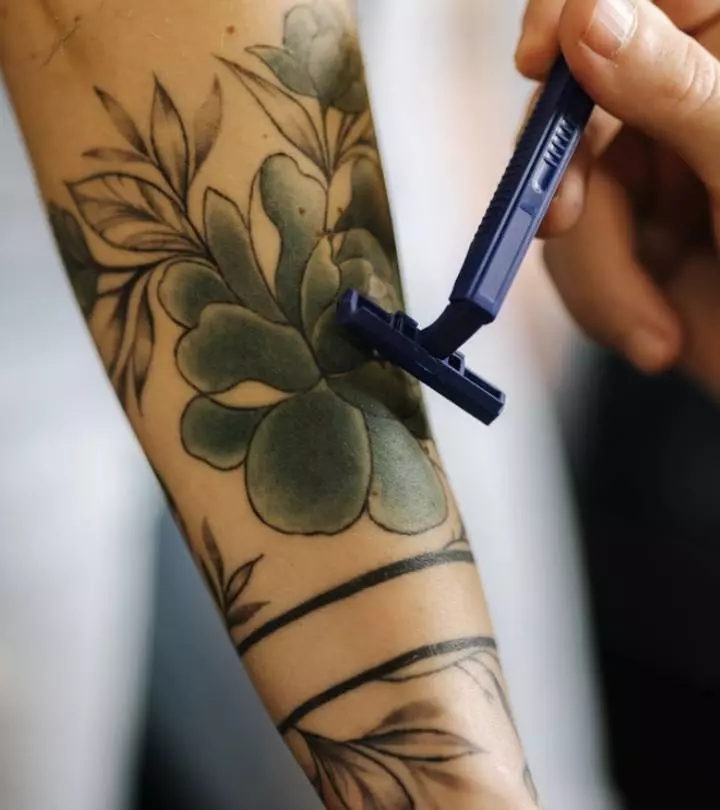Can You Ice A Tattoo? Benefits And Safety Tips
Discover the benefits of icing your new tattoo to get relief from itchiness.

Image: iStock
Icing a wound is common practice for soothing discomfort caused by inflammation after a trauma, but can you ice a tattoo? The short answer is yes. It is a simple practice that involves applying ice in a sealed bag to freshly inked skin after covering it with a clean cloth. This can help reduce inflammation and numb the area. Tattoo artists often recommend it to aid the natural healing process after getting a fresh tattoo and get temporary relief from the pain and swelling associated with the tattooing procedure. While it is a widely accepted practice, caution is necessary to avoid causing potential harm to the tattooed skin during the application. Are you interested in learning more about this method to soothe your tattooed area? Continue reading.

In This Article
Importance Of Tattoo Aftercare
Proper tattoo aftercare is essential for ensuring your tattoo heals well and retains its vibrant look over time. It helps prevent infections, scarring, and fading of the ink. Following aftercare instructions like keeping the area clean, moisturizing, and avoiding sun exposure can protect the skin and maintain the quality of the design. However, neglecting aftercare can lead to serious complications that affect both the appearance and health of your tattoo.
Now read on to learn if icing your tattoo can help with aftercare!
Key Takeaways
- Use a cloth barrier with short intervals for effective and safe ice pack application.
- Ice periodically for 10-15 minutes during the initial 24-48 hours, reducing frequency as healing progresses.
- It will help reduce swelling, bruising, and pain to help assist the tattoo healing process.
- Exercise moderation to avoid potential adverse effects such as frostbite.
Can You Ice A Tattoo?

Icing a tattoo involves applying a cold compress or ice pack to freshly inked skin, primarily in the initial stages of the tattooing process. This method mitigates discomfort, numbs the area, and diminishes swelling which is a common effect of getting a tattoo. Tattoo artists often advise clients to ice their tattoos to help with pain management. But remember that it should not be used excessively. Blood flow is required to heal the damaged tissue.
The cold application constricts blood vessels, reduces blood flow to the area, and minimizes inflammation. It is crucial, however, to exercise caution during this process and to ensure that the ice or cold compress is applied gently and not directly on the skin for extended periods to prevent any potential harm or damage to the tattooed area.
 Pro Tip
Pro TipA cold compress can be applied to soothe your inflamed tattoo. But what is the correct way to apply an ice pack over your tattoo without aggravating it? Let us find out in the section below.
Methods For Using An Ice Pack On A Tattoo
Employing proper techniques is essential for effective relief and healing when you ice a new tattoo. You can follow the methods mentioned below to ice your tattoo.
- Wrap The Ice: Encase the ice pack in a thin, clean cloth or towel to create a protective barrier to prevent direct contact with the tattooed skin which can be too harsh.
- Apply In A Gentle Motion: Apply the ice pack by gently pressing it against the skin. Avoid rubbing as it may cause discomfort.
- Do It In Short Intervals: Use the ice pack in brief 10 to 15-minute intervals to prevent overexposure.
- Let It Rest: Allow the skin to rest between applications to avoid aggravating the skin.
- Rotate The Ice Pack: If using multiple ice packs, rotate them to maintain a consistent temperature without excessive cold exposure.
- Follow The Artist’s Guidance: Adhere to any specific instructions from your tattoo artist regarding ice pack application for optimal healing.
- Exercise Moderation: Practice moderation to prevent potential adverse effects, such as frostbite.
Rachel, a blogger, shares her experience of trying to reduce swelling after she got a lower leg tattoo. She writes, “Then it swelled a bit more and spread into my foot. Needless to say, I was a little disconcerted, so I of course ‘googled’ it. This is where I hit a wall (i).” She goes on to share some tips that helped her reduce the swelling and continues, “Ice your foot, as you would if you sprained it. A good 15-20 minutes should help alleviate some of the pressure.”
Applying a cold compress to your tattoo while avoiding direct contact is important. If you need a cold compress but do not have a ready-made one handy, you can easily make one at home. Find out how to make it in the next section.
How To Make A Cold Compress?

For quick and effective relief from an inflamed tattoo, follow the simple steps below to make a cold compress at home.
- Dampen a clean cloth with cold water or wrap ice cubes in the cloth.
- Place the cloth in a sealable plastic bag and remove excess air before sealing.
- Allow the compress to chill in the freezer for about 15 minutes. Once adequately cold, apply it to the affected area for relief.
- Be cautious not to apply the cold compress directly to the skin; use a clean towel as a barrier to prevent aggravating the area or
- causing discomfort during application.
Being able to make a cold compress at home is certainly handy, but it is also essential to know how long and how often you can apply it over a tattoo to avoid causing it any harm. The next section addresses these questions.
How Often Should You Ice A Tattoo?
Ice a tattoo every 2-4 hours during the initial 24-48 hours, with short 10-15 minute sessions. After the first two days, reduce the frequency to avoid overexposure. Follow the specific guidelines and aftercare instructions provided by your tattoo artist, as individual healing processes may vary. Be attentive to your body’s response, and if discomfort persists or worsens, consult your tattoo artist or a healthcare professional. Icing for longer periods of time can potentially hinder the healing process, so it’s important to strike a balance between providing relief and allowing the natural recovery of the tattooed area.
Overexposure to cold can compromise your tattoo’s healing process, so being mindful is key to reaping the benefits of icing your tattoo. But what are they? Let us specifically discuss them in the next section.
The Benefits Of Icing A Tattoo

Icing tattoos yields several crucial benefits to the post-tattoo healing process. Take a look at them below.
- Reduces Pain: Icing your tattoos helps numb the area, providing immediate pain relief during the initial stages of healing.
- Minimizes Swelling: It helps reduce inflammation and minimize swelling, contributing to a smoother recovery process.
- Decreases Bruising: It may help minimize bruising around the tattooed area and contribute to a cleaner appearance.
- Provides Relief: Icing assists in managing and soothing the prickling sensations after getting a tattoo.
- Reduces Bleeding: As ice causes the blood vessels to constrict, it may help slow down the blood flow and lower the risk of bleeding during the healing phase.
- Enhances The Aftercare Process: Incorporating icing into aftercare routines enhances the overall experience of caring for a new tattoo, making it more tolerable for individuals.
In addition, always make sure to follow proper aftercare practices such as using mild, antibacterial soap and lukewarm water to clean the tattoo. You must keep your tattoo dry so use a clean paper towel to pat it dry. Follow it up by applying an antibacterial ointment and an unscented lotion in a thin layer 4-5 times per day to keep the skin hydrated and assist in healing. Opt for soft and loose clothing and always use SPF 30 or above sunscreen to protect your tattoo from sun exposure.
Note: Avoid using a lotion within the first two weeks of getting a tattoo. You may use it after that. But should the need arise, you may use an ointment prior after consulting your doctor.
 Did You Know?
Did You Know?The cold can help you in your tattoo recovery journey. But it can also have some adverse effects on your healing ink art. To find out what they are, check out the following section.
Side Effects Of Using Ice Pack On Tattoos
While using ice packs on tattoos can offer relief, it is important to be aware of potential side effects that may arise from improper application or excessive use.
- Risk Of Frostbite: Applying ice directly to the skin or for extended periods may increase the risk of frostbite, causing damage to the tattooed area.
- Discoloration: Prolonged exposure to cold temperatures might lead to temporary discoloration of the tattooed skin.
- Nerve Damage: Some individuals may experience heightened skin sensitivity or irritation due to the cold temperature of the ice pack. Excessive use can potentially cause nerve and tissue damage and impact the sensation in and around the tattooed area.
- Delayed Healing: Ice constricts blood vessels and may reduce blood flow to the area. This could hinder the delivery of essential nutrients and oxygen needed for tissue repair.
Tending to your tattoo’s well-being is essential as it embarks on its healing journey. If you are wondering how to take care of a new tattoo, your attentiveness plays a crucial role in relieving discomfort and optimizing the recovery process. Remember, each tattoo healing experience is unique, and understanding your body’s signals is key. Approach tattoo aftercare with a mindful balance, considering the specific needs of your inked canvas. As you navigate the post-tattoo period, listen to your body, follow professional advice, and embrace a measured approach. By doing so, you contribute to a positive healing environment, allowing your tattoo to flourish and become a lasting work of art on your skin.
Frequently Asked Questions
Can I ice an infected tattoo?
No, avoid icing an infected tattoo. Applying ice may worsen the bacterial infection by constricting blood vessels. Seek professional medical advice for proper treatment and care of an infected tattoo.
Can I ice a tattoo with Saniderm?
It’s advisable not to ice a tattoo with Saniderm or any film dressing. These dressings provide a protective barrier, and icing may compromise their efficacy. Follow specific tattoo care instructions for faster healing.
Should I use a hot or cold pack on my tattoo?
Use a cold pack on your tattoo for the first 48 hours to reduce the annoying redness and swelling. Using a hot pack on a fresh tattoo is generally not recommended as it may aggravate the skin and increase the risk of infection.
What signs should I look for if my tattoo is infected?
Redness, swelling, pus, and a persistent bad odor are signs of infection. Moreover, if you experience persistent pain, it could be a sign of infection. Systematic symptoms, such as fever, chills, and nausea after tattoo art, can also indicate an infection. If you notice these, seek medical advice.
Illustration: Can You Ice A Tattoo? Benefits And Safety Tips

Image: Dall·E/StyleCraze Design Team
Personal Experience: Source
StyleCraze's articles are interwoven with authentic personal narratives that provide depth and resonance to our content. Below are the sources of the personal accounts referenced in this article.
(i). Tattoos: Tips on swollen legs and feet after a tattoohttps://illustratedteacup.com/2014/02/reduce-foot-and-leg-swelling-after-tattoo.html
Read full bio of Mengni Yang
Read full bio of Shreya Mukherjee
Read full bio of Subhrojyoti Mukherjee
Read full bio of Gazala Firdos Ansari


























Community Experiences
Join the conversation and become a part of our empowering community! Share your stories, experiences, and insights to connect with other beauty, lifestyle, and health enthusiasts.